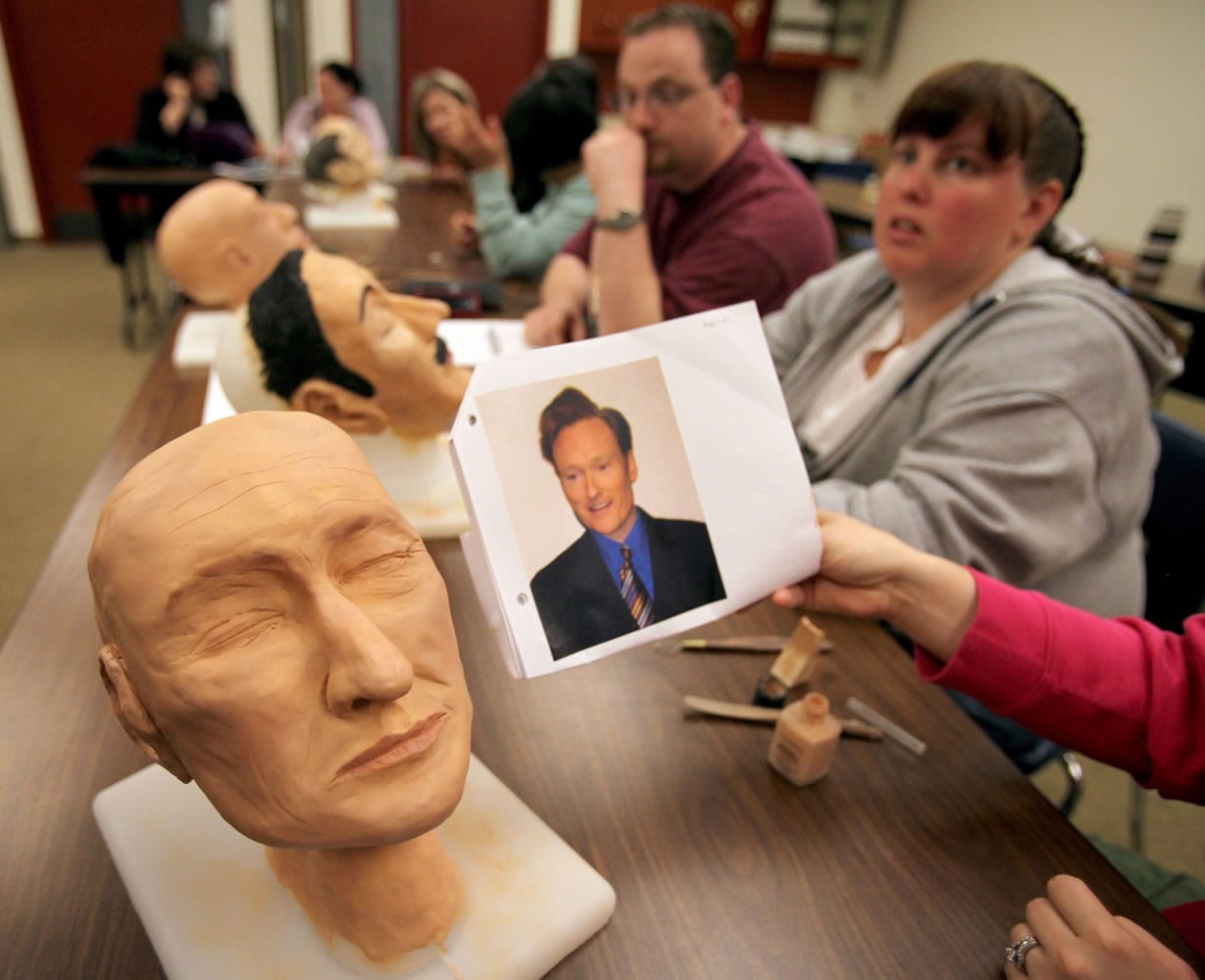KIRKLAND — One student was painting a mustache, completing the process of turning a wax-covered skull into the image of Walt Disney. Another was crafting the elongated ears of poet Allen Ginsberg.
Randi Cloud had chosen to create the visage of Conan O’Brien, with a picture of the television talk-show host propped in front of her.
The students were in one of the required classes of a new Funeral Service Education program at Lake Washington Technical College in Kirkland, the first such program in Washington state. The first class of seven students graduated Friday, and a second class of nine will graduate in August.
“This is something I’ve wanted to do for quite a while,” said Cloud, who has experienced deaths in her family. “I felt like this was something I could do a good job at because I’ve been through it. People don’t like going to funerals, but if I can be sensitive to those things I can be a good funeral director.”
The need is so great for funeral directors and embalmers that the state added the program two years ago.
Until Lake Washington began its program, local mortuary-science students had to travel to Oregon, California or even farther away to receive training required to be licensed in Washington.
The program is complex. Students learn business aspects of running a funeral home, the psychology of dealing with grieving family members and the science of embalming. They also learn restorative art. They may be faced with restoring the body of a gunshot victim, or someone who died in a car accident — hence the skull class.
Christina Graylee, 32, will graduate in August. She said she has wanted to become a funeral director since she was a teenager. She was reared by her grandparents, and she saw all the care that the funeral director gave when her grandmother died.
“I want to help people who are grieving and be there for strangers who go through their worst days,” said Graylee, a single mother and former college dropout who was working for a tool company before she went back to school. “I had an interest in science and art, and I really respect the dead. The dead don’t have a say.”
She said she was a little nervous about embalming. Once she did it, though, she realized the human body is a beautiful thing. “I know the person is not there anymore, so I want to make them look as good as possible.”
When Robin Grant graduated from Washington State University with a biology degree, she couldn’t find a job. So she decided to become a funeral director and embalmer. Grant, 24, was in the first graduating class Friday.
“I really liked it,” Grant said. “I love the science and the anatomy, putting things back together and seeing how it works.”
Erin Wilcox, director of the program, said she began in the field by working at a funeral home in college, mowing lawns, washing the hearse and taking out the garbage. She graduated from college with degrees in English and religion, but her boss then asked if she’d consider being a funeral director.
“I figured maybe deep down I did,” she said. “But I didn’t want to admit it.”
She graduated from mortuary school in California and worked as a funeral director and embalmer for five years before joining Lake Washington.
“It takes a special kind of person,” Wilcox said. “It’s very emotionally stressful, and you’re on call 24/7. You sacrifice a lot for it, and it takes up your life. It’s very fulfilling, but it’s not for everyone.”
Although Lake Washington trains its students in both aspects, a funeral director and an embalmer have separate roles in treating deaths. The funeral director arranges for disposal of the body, prepares the deceased for viewing and arranges an embalming.
The embalmer might not have contact with the family. He or she has been trained in the art and science of embalming, including anatomy and chemistry.
Embalming involves washing a body and injecting a preservative to ready it for viewing and placement in a casket. Once that is completed, the embalmer rewashes the body, including shampooing the hair and cleaning the fingernails. The embalmer also applies cosmetics.
Adam Horton, 33, has a teaching degree from the University of Washington and almost had his master’s degree in education, but he decided to change careers.
He had worked in administration at a funeral home and decided he would like to be a funeral director. “It’s meaningful and worthwhile,” he said, while crafting his plastic skull into Ginsberg, one of his favorite poets.
According to the Department of Licensing, the state has 285 licensed embalmers and 396 licensed funeral directors, and many hold both licenses. King County has 68 embalmers and 95 funeral directors.
While embalming may not be as much in demand — about 70 percent of those who died in this state are cremated, according to the state Health Department — it’s becoming more difficult to find people with both licenses.
The Lake Washington program expects to receive accreditation from the American Board of Funeral Service Education this summer.
Cameron Smock, president of the Washington State Funeral Directors Association and president and CEO of Bonney-Watson, said he is so pleased by the new program that he’s already hired a graduate.
“For many people who are doing this as a second or third career, they have families and mortgages and can’t relocate out of state,” he said. “Having an in-state program really aids their ability. And we don’t have an appropriate pool of qualified applicants.”



